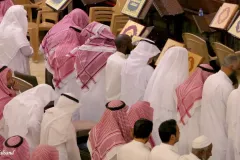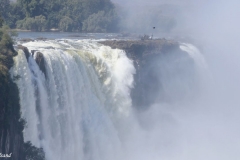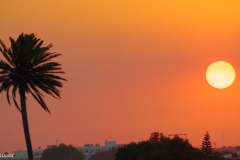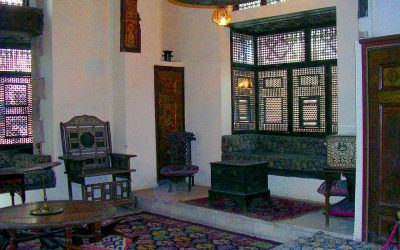Intro
Countries
Photos
Blog
Facts
Overall impressions
This image is from a distinct part of the Middle East and Africa. A group of men in traditional Arab attire had crossed a bridge over the River Euphrates. This was in the eastern Syrian town of Deir-es-Zor. Only minutes before, I had checked into a rather modest hotel room across the street.
Looking out the window, I could not resist the opportunity to take this photograph. There is nothing in particular going on and there are no telling surroundings. Yet, this picture symbolises a good deal to me if I generalise it to a regional context. Proud and traditional peoples with a very long history inhabit this region. They have strong religious sentiments. Besides, it’s a man’s world.
The Middle East and North Africa consists for the most part of Muslim countries. There are also large and important groups of Jews and Christians. In geopolitical terms, this region has for the last few decades been at the centre of the world’s focus. It contains some important root causes of much of the world’s disorder. For one thing this is due to the Israeli-Arab conflict. Second, the rich petroleum resources are of vital interest to the rest of the world.
Up until recently I have not had many impressions from the rest of this region, Africa. That has now changed as I have started to explore Africa south of the Sahara. Have a look at the map below.
Countries
Algeria | Angola | Benin | Burkina Faso | Burundi | Cameroon | Cape Verde | Central African Republic | Chad | Comoros | Congo R | Congo DR | Djibouti | Equatorial Guinea | Eritrea | Ethiopia | Gabon | Gambia | Ghana | Guinea | Guinea-Bissau | Iran | Iraq | Ivory Coast | Kenya | Kuwait | Lebanon | Lesotho | Liberia | Libya | Madagascar | Malawi | Mali | Mauritania | Mauritius | Mozambique | Niger | Nigeria | Oman | Rwanda | São Tomé and Príncipe | Senegal | Seychelles | Sierra Leone | Somalia | South Sudan | Sudan | Swaziland | Tanzania | Togo | Tunisia | Uganda | Yemen
The Middle East consists of 17 countries, or 16 if one omits Palestine. They stretch from Türkiye (formerly Turkey) in the north and west, to Iran in the east, and also south on the Arabian Peninsula.
In Africa there are 54 independent countries and 10 non-sovereign territories.
As the map shows, I have been to very few. That is why I chose to split the country list above into the have-beens and not. In all I have made it to 16 independent countries out of 71.
One final note. I have for practical purposes grouped the Middle East and Africa into one region. It is not a coherent territory. Africa is a continent, but the Middle East is part of Asia.
However, the Middle East has very much in common with North Africa for many reasons (cultural, ethnic, religious, historical, economic etc.).
Sub-Saharan Africa differs in most respects. Read the fact sheet below.
Photo galleries
Open the box to view picture galleries from Sandalsand’s travels in this region.
Click to show or hide
Tip: Open a picture galleries in a new tab or window.
Posts from the Middle East and Africa
VIDEO – Egypt – The Nile (3) Edfu
This video is from Edfu, some 115 km north of Aswan and 100 km south of Luxor. It is the third video from a cruise on the Nile from Aswan to Luxor....
Aswan and the south
Our tour of the Nile started with a night train up the Nile to Aswan and continued on a cruise ship north to the temples of Kom Ombo, Edfu and Esna....
VIDEO – Egypt – The Nile (2) Kom Ombo
This video is from the Temple of Kom Ombo some 50 km north of Aswan. It is the second video from a cruise on the Nile from Aswan to Luxor. The...
VIDEO – Egypt – The Nile (1) Aswan
This video is from Aswan. It is the first video from a cruise on the Nile from Aswan to Luxor. The stops: Aswan - Kom Ombo - Edfu - Esna - Luxor....
VIDEO – Egypt – The Nile (9) Giza
This video from Giza includes the World Heritage Site "Memphis and its Necropolis - the Pyramid Fields from Giza to Dahshur". It is no. 86 on...
World Heritage #0086 – The Pyramids
Every person on earth have heard of, and seen a picture of the Pyramids and the Sphinx. They have been around for thousands of years. The...
Cairo and the Pyramids
We went on a spontaneous tour of Egypt. This time it was my youngest (at the time 7 years of age) son who joined me to Cairo and the Pyramids, and...
World Heritage #0089 – Historic Cairo
Cairo is truly historic. The capital of Egypt has for millennia been at the centre of world history, and there is much to discover here. The UNESCO...
Pictures from Türkiye
This is a collection of Sandalsand's pictures from Türkiye (formerly Turkey). They are the result of trips to different parts of the country. If you...
Sun, sand and more in Alanya, Turkey
Sun and bath on the Turkish Med coast with a short look behind the tourist façade and a visit to a world renowned natural wonder. That is the...
World Heritage #0485 – Hierapolis-Pamukkale
Come for a bath and a look at the great white terraces of the heritage site Hierapolis-Pamukkale in central Turkey. The UNESCO World Heritage List...
A two day excursion inland from Alanya to Pamukkale, Turkey
From the first time I saw pictures of Pamukkale I dreamed of going there myself. My dream came true. About Pamukkale Pamukkale means...
Pictures from Israel and Palestine
This is a collection of Sandalsand's pictures from Israel and Palestine. Most images are from Jerusalem, some also from the West Bank and parts of...
A dive into ancient history in Israel and Palestine
This visit to Israel and Palestine is the last part of my five week journey. I had finally come to the Promised Land. Also, I found my way into...
World Heritage #1433 – Bethlehem
Bethlehem, a town to the southeast of Jerusalem is inscribed on the Heritage List for one reason. It is by tradition the birthplace of Jesus...
World Heritage #0148 – Old City of Jerusalem
This world heritage site, the Old City of Jerusalem and its Walls, is a holy city for three religions. They have fought over Jerusalem for...
Pictures from Jordan
This is a collection of Sandalsand's pictures from Jordan. They are from the capital Amman as well as other parts of the country. If you look up all...
World Heritage #0689 – As-Salt
As-Salt is a Jordanian town which had its Golden Age in the years between the 1860's to the 1920's. UNESCO calls it a place of tolerance and...
Jordan’s capital, Petra and the Dead Sea
Few places on planet Earth are as legendary as Petra, and few activities as fascinating as swimming in the Dead Sea. This chapter of my journey also...
World Heritage #0326 – Petra
The narrow entrance to the town of Petra, this ancient civilisation in the desert of Jordan, is perhaps the world's most famous. The UNESCO...
Pictures from Syria
This is a collection of Sandalsand's pictures from Syria. They are from a journey to almost all corners of the country. If you look up all articles...
Deserts, towns and memorials of Syria
Read about deserts, towns and memorials of Syria. Syria was a closed country, not welcoming tourists. But what an exciting past and present! In...
World Heritage #0020 – Damascus
The ancient city of Damascus, the Syrian capital, is one of the most intriguing cities of the Middle East, but also one of the most troublesome to...
World Heritage #1229 – Crac des Chevaliers
The Crusader castles Crac des Chevaliers and Qal’at Salah El-Din in Syria are old and remarkably intact. The UNESCO World Heritage List includes...
Let me tell you something that we Israelis have against Moses. He took us 40 years through the desert in order to bring us to the one spot in the Middle East that has no oil! (Golda Meir)
A fact sheet
This is from Wikipedia’s introduction to the two regions I have combined on this page.
The Middle East
Map and numbers

- Region: Middle East
- Area: 7,207,575 km2
- Population: 371 million (2010)
- Countries: 18 countries plus a few dependencies and disputed territories
- Languages: ~60 languages
Geography and demography
The Middle East refers to the region spanning the Levant, Arabian Peninsula, Anatolia (including modern Turkey and Cyprus), Egypt, Iran and Iraq. This term replaced the Near East (as opposed to the Far East) in the early 20th century.
The history of the Middle East dates back to ancient times. The geopolitical importance of the region has been recognized for millennia. Several major religions have their origins in the Middle East, including Judaism, Christianity, and Islam. Arabs constitute the main socioethnic grouping in the region. Others include Turks, Persians, Kurds, Azeris, Copts, Jews, Assyrians, Iraqi Turkmen, and Greek Cypriots.
The Middle East has a hot, arid climate, especially in the Peninsula and Egyptian regions. Several major rivers provide irrigation to support agriculture in limited areas. The most important rivers are the Nile Delta in Egypt, the Tigris and Euphrates watersheds of Mesopotamia (Iraq, Kuwait, and eastern Syria), as well as the Fertile Crescent.
Most of the countries that border the Persian Gulf have vast reserves of petroleum.
Other concepts of the region exist too. One is the broader Middle East and North Africa (MENA), which includes states of the Maghreb and Sudan. Another, the “Greater Middle East”, includes parts of East Africa, Afghanistan, Pakistan, and sometimes the South Caucasus and Central Asia.
Africa
Map and numbers

- Region: Africa
- Area: 30,370,000 km2
- Population: 1,275,920,972 (2018)
- Population density: 36.4/km2
- Nominal GDP: $2.19 trillion (2021)
- PPP GDP: $6.84 trillion (2021)
- Per capita GDP: $1,860 (2021)
- Demonym: African
- Countries: 54 (and 2 disputed)
- Dependencies: External (5), Internal (6)
Geography
Africa is the world’s second-largest and second-most populous continent, after Asia in both cases. At about 30.3 million km2 including adjacent islands, it covers 6% of Earth’s total surface area and 20% of its land area. With 1.3 billion people as of 2018, it accounts for about 16% of the world’s human population. The continent is surrounded by the Mediterranean Sea to the north, the Isthmus of Suez and the Red Sea to the northeast, the Indian Ocean to the southeast and the Atlantic Ocean to the west.
The continent includes Madagascar and various archipelagos. It contains 54 recognised sovereign states (countries), eight territories and two de facto independent states with limited or no recognition.
Africa straddles the equator and the prime meridian. This makes it the only continent in the world situated in all four cardinal hemispheres. It is the only continent to stretch from the northern temperate to southern temperate zones. The majority of the continent and its countries are in the Northern Hemisphere.
Demography and history
Africa’s population is the youngest amongst all the continents. The median age in 2012 was 19.7, when the worldwide median age was 30.4.
Africa, particularly Eastern Africa, is widely accepted as the place of origin of humans and the Hominidae clade (great apes).
Early human civilisations, such as Ancient Egypt and Carthage emerged in North Africa. Due to a long and complex history of civilisations, migration and trade, Africa hosts a large diversity of ethnic groups, cultures and languages.
In the late 19th century, European countries colonised almost all of Africa. They extracted resources from the continent and exploited local communities. Most present states in Africa emerged from a process of decolonisation in the 20th century.
Source
Wikipedia on a Creative Commons Attribution-ShareAlike License. Date: 2022-03-09.











































